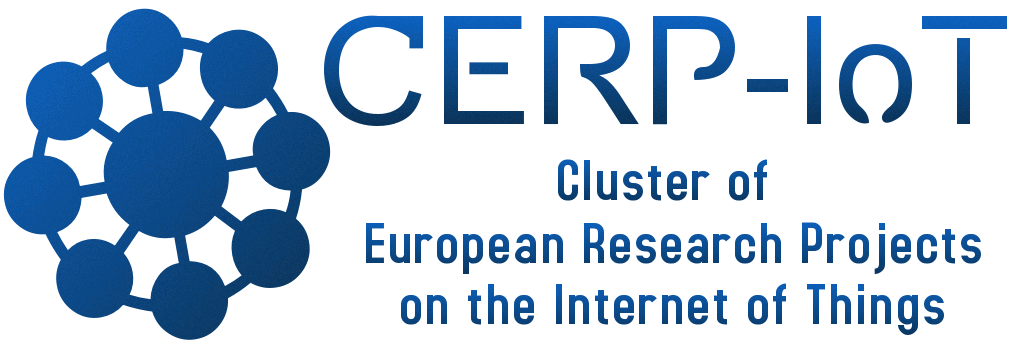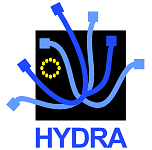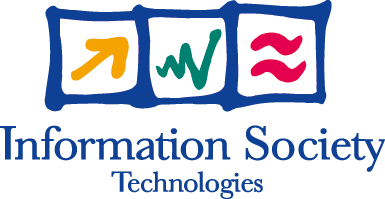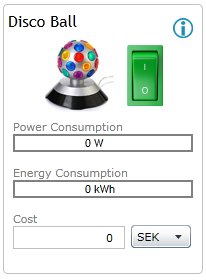Web Links: Related projects
| AMIGO | |
| Ambient intelligence for the networked home environment. The Amigo project aims to overcome the obstacles to widespread acceptance of home networking technology. The project will develop open, standardized, interoperable middleware and attractive user services, thus improving end-user usability and attractiveness. The project will show the end-user usability and attractiveness of such a home system by creating and demonstrating prototype applications improving everyday life, addressing all vital user aspects: home care and safety, home information and entertainment, and extension of the home environment by means of ambience sharing for advanced personal communication. The Amigo project will further support interoperability between equipment and services within the networked home environment by using standard technology when possible and by making the basic middleware (components and infrastructure) and basic user services available as open source software together with architectural rules for everyone to use. |
|
| Date Added: 20/11/2007 10:31 | Visits: 2917 |
| ASTRALS | |
| Audio-visual STReaming plAtform for domestic Leisure and Security. ASTRALS (IST-028097) is a project focused on personalised scalable A/V encoding, transcoding/ transrating, storage and distribution in existing households via streaming-optimised wireless links. ASTRALS motivation is to implement scalable solutions, which will enable a new beam of innovative A/V products and services including personalised, network-aware video adaptation and distribution in multiple heterogeneous terminals (from low-cost PDAs to high-end home cinemas) and intelligent surveillance, utilising a broadband in-home network. ASTRALS envisages a personalised, network agnostic, A/V architecture. A state-of-the art Residential Gateway, enhanced with A/V optimised and broadband wireless extensions, will be the centre of ASTRALS home-centred A/V platform. Without excluding legacy network interfaces, ASTRALS will specify and prototype a streaming-optimised, IEEE 802.16 based, wireless platform as the major in-home distribution medium. MIMO simulations and mesh architecture will provide for efficient home coverage and ad-hoc networking, with minimal administration requirements. |
|
| Date Added: 03/01/2008 11:59 | Visits: 2520 |
| ebbits | |
| The ebbits project aims to develop architecture, technologies and processes, which allow businesses to semantically integrate the Internet of Things into mainstream enterprise systems and support interoperable real-world, on-line end-to-end business applications. It will provide semantic resolution to the Internet of Things and hence present a new bridge between backend enterprise applications, people, services and the physical world, using information generated by tags, sensors, and other devices and performing actions on the real-world. The ebbits platform will support interoperable business applications with context-aware processing of data separated in time and space, information and real-world events (addressing tags, sensor and actuators as services), people and workflows (operator and maintenance crews), optimisation using high level business rules (energy and cost performance criteria), end-to-end business processes (traceability, life-cycle management), or comprehensive consumer demands (product authentication, trustworthy information, and knowledge sharing). The ebbits project is building on Hydra middleware for interoperability. |
|
| Date Added: 24/09/2010 20:56 | Visits: 2367 |
| eDIANA | |
| eDIANA (Embedded Systems for Energy Efficient Buildings) addresses the need of achieving energy efficiency in buildings through innovative solutions based on embedded systems. The eDIANA Platform is a reference model-based architecture, implemented through an open middleware including specifications, design methods, tools, standards, and procedures for platform validation and verification. |
|
| Date Added: 23/11/2010 21:51 | Visits: 2821 |
| eu-DOMAIN | |
| The eu-DOMAIN project is a FP6 funded project developing an innovative ambient intelligence service platform for automatic and context sensitive offering and contracting of mobile services across heterogeneous networks. eu-DOMAIN supports mobility among users and workers by integrating them with seamlessly accessible ubiquitous intelligent surroundings that support self-configuring devices using semantic agents and tools for ambient awareness and decision support. |
|
| Date Added: 20/11/2007 11:09 | Visits: 2769 |
| GOLLUM | |
| GOLLUM aims at studying and creating key parts of an open, operating system independent link-layer API to support heterogeneous systems by unifying the various methods for accessing different wired and especially wireless links. Embedded system are also considered. The aim is to remedy the current, very difficult situation where a separate programming interface exists for almost every wireless technology. The existence of such an API and corresponding middleware would greatly improve interoperability between various technologies. It would enable better portability of applications between devices using different, usually wireless, communication interfaces. |
|
| Date Added: 20/11/2007 11:11 | Visits: 2792 |
| inCASA | |
| The inCASA project is a 30-months project funded with the aim to create and demonstrate citizen-centric technologies and a services network that can help and protect frail elderly people and prolong the time they can live well in their own homes. The goal will be achieved by a series of pilots across Europe that integrate solutions and services for health and environment monitoring in order to profile user behaviour. Data will be made available to professional care service providers including privacy protection; day-by-day activity planning; co-ordination of Public Social and Health Care Services; and deployment of specialist community based services. People at home will live their lives as usual, but Home Sensor Networks and Human Monitoring Sensors (HMS) will monitor their lifestyle and will interact, if needed, with the citizen themselves or with the Service Provider. The infrastructure will be based on the Hydra middleware. |
|
| Date Added: 18/10/2010 17:28 | Visits: 4866 |
| MADAM | |
| Computers and networking technology are becoming an integral part of our living and working environment. The increasing mobility and pervasiveness of computing and communication enables new services and applications that can improve quality of work and life. However the constant change that characterize mobile environment - e.g. network, battery, light and noise conditions - poses a significant challenge to developers. To retain usability, usefulness, and reliability applications need to adapt to the changing operating environment and the context in which they are used. Existing software development methodology and middleware technology do not support such dynamically adaptive applications. The overall objective of MADAM is to provide software engineers with modelling language extensions, tools and middleware that collectively foster the design, implementation and operation of innovative applications and services for the mobile user and worker. To achieve this objective we will study the adaptation requirements of mobile applications and develop a theory of adaptation. A set of reusable adaptation strategies and adaptation mechanisms, based on dynamically reconfigurable component architecture will be developed. Modelling language extensions and tools will enable application designers to specify adaptation capabilities at design time. |
|
| Date Added: 20/11/2007 11:14 | Visits: 3460 |
| REACTION | |
| The REACTION project (Remote Accessibility to Diabetes Management and Therapy in Operational Healthcare Networks) seeks to use the significant potential of new technologies to help cope with diabetes. The REACTION platform will apply a service-oriented architecture, taking advantage of the LinkSmart middleware developed in the Hydra project for detection of devices and creation of web service interfaces, thus building on and adding to the progress already made in the Hydra project.design methodology, underpinned by a user-centric and iterative development process. REACTION is a four-year project approved under the Seventh Framework Programme, with sixteen partners from ten European countries cooperate in the project, some of which are also contributing partners in Hydra. |
|
| Date Added: 25/08/2010 13:40 | Visits: 13069 |
| SIRENA | |
| The SIRENA project intends to create a service-oriented framework for specifying and developing distributed applications in diverse real-time embedded computing environments, including industrial automation, automotive electronics, home automation and telecommunications systems. Though very diverse, these domains have a lot in common as far as the basic communications and control infrastructure is concerned. SIRENA will develop a set of common services to address this common denominator, complemented with domain-specific services for each of the target domains. |
|
| Date Added: 20/11/2007 11:12 | Visits: 2701 |
| SOCRADES | |
| The SOCRADES integrated project will create new methodologies, technologies and tools for the modelling, design, implementation and operation of networked systems made up of smart embedded devices. Achieving enhanced system intelligence by co-operation of smart embedded devices pursuing common goals is relevant in many types of perception and control system environments. In general, such devices with embedded intelligence and sensing/actuating capabilities are heterogeneous, yet they need to interact seamlessly and intensively over a (wired or wireless) network. The middleware technologies to be developed in this project will be based on the Service-Oriented Architecture (SOA) paradigm, will encompass both wired and wireless networking technologies, and will provide open interfaces enabling interoperability at the semantic level. A SOCRADES service will be a software component encapsulating device-specific functionality. This functionality is advertised to the outside world, so as to be located and invoked by other networked devices and/or applications without the latter being aware of how the functionality is implemented. |
|
| Date Added: 20/11/2007 11:14 | Visits: 2925 |
| SODA | |
| SODA is a follow-up project of SIRENA. The objective of the SODA project is to create a comprehensive, scaleable, easy-to-deploy ecosystem built on top of the foundations laid by the SIRENA project, which broke new ground by developing an infrastructure for high-level communications between devices, based on the service-oriented architecture (SOA) paradigm. The SODA ecosystem will comprise a comprehensive tool suite and will target industry-favourite platforms supported by wired and wireless communications. |
|
| Date Added: 20/11/2007 11:13 | Visits: 2618 |
| UBISEC | |
| UBISEC's mission is to address new business areas and technologies originating from the integration of public wide area networks (e.g., cellular, Internet), and private corporate and home/SOHO local area networks. This integration is commonly expected to create new markets and new opportunities, hence helping European telecommunication network operators and smart card integrators to secure leadership in those markets. The new integrated networks will create new demands in terms of services and will improve quality of life for the users both in their private or professional environment. In order to address the related issues and technology challenges, UBISEC is aiming at an advanced infrastructure for large-scale mobility and security based on SmartCard technologies for context-aware and personalised authorisation and authentication services in heterogeneous networks. This requires advanced personalisation and localisation technologies with high security in order to keep privacy and to protect computing devices, their software components, and personal user data including user profiles. |
|
| Date Added: 20/11/2007 11:15 | Visits: 2844 |
| VAN | |
| The total automation market volume in 2004 amounted to 203 Billion Euro. The European market share was 25% with regard to application, whereas it was 32% with regard to production of automation equipment. This shows an exported surplus of European automation products of 7%. This clearly marks Europe's leadership in the global automation market, which has to be conserved and extended. These facts are depicted in the two following diagrams. The VAN project will provide innovative solutions, extensions and standards dedicated to industrial environments, to fill the existing gap between office technologies and industrial automation technology, focused on a new dimension of uniform networking of production and manufacturing processes. |
|
| Date Added: 20/11/2007 11:12 | Visits: 2492 |





 The Hydra project is co-funded by the
The Hydra project is co-funded by the 


